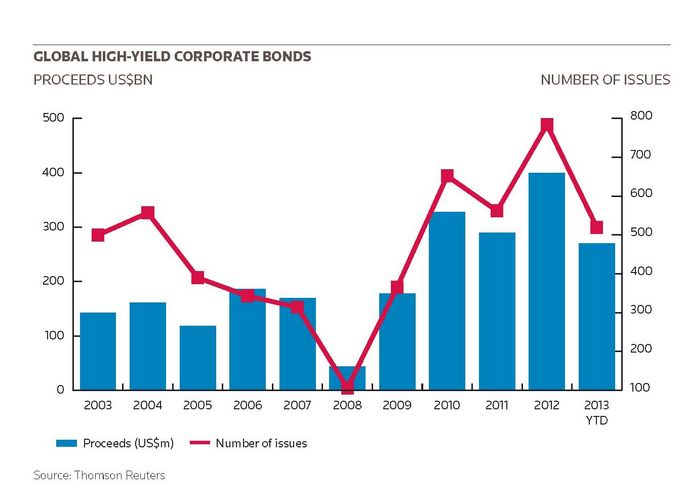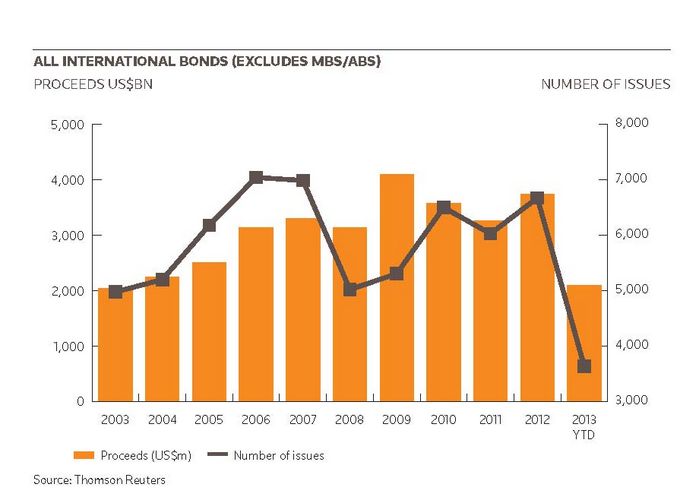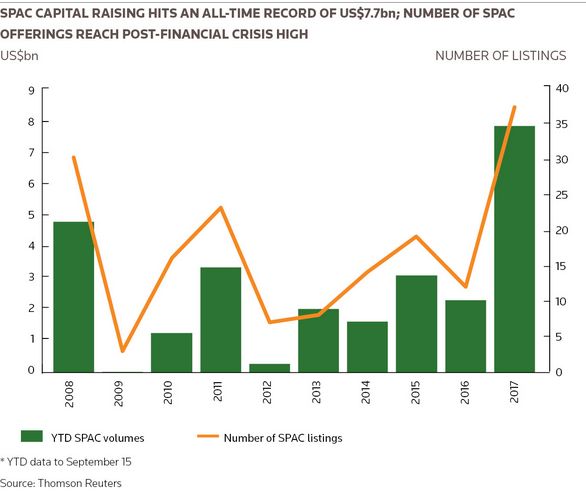To view the digital version of this report please click here.
To purchase printed copies or a PDF of this report, please email gloria.balbastro@thomsonreuters.com.
Martin Egan, BNP Paribas: I think banks will definitely try to create a European PP market. I’m encouraged by the development in the Schuldschein space, for example, but it’s a long way off and it’ll be many years before it will approach the size and scale of the USPP market. But the mindset is changing. From the European bank perspective, I’m sure that near the top of each institution’s agenda is a strong desire to develop a PP market in Europe.
It won’t answer the question of market accessibility as you go down the credit spectrum, but in terms of market development it’s something that I’ll spend money on going forward, and I think other European banks will as well. We need to develop a bigger PP market in Europe.
Claus Skrumsager, Morgan Stanley: I think the private placement debate is different to the one James highlighted around developing a high-yield market. It would be great if we could develop a US-style private placement market, but an unlisted NAIC-rated type market is a long way off. The private placements we have seen this year – and we’ve all been very busy in that space – have been a harbour for the huge liquidity that insurance companies and pension funds in particular are sitting on, but under Solvency II long-dated credit is heavily penalised.
So I think we’re some way from that. I think the key thing for our market to prosper is a relatively low volatility transition from the rate bubble we’re in to a more normalised rate equilibrium, and then growth. Growth, a little bit back to your point, Jim, is about the ability to develop more lending for SMEs, which is one of your questions, Keith.
I think an interesting statistic here is that 92% of European corporations have fewer than 10 employees; 95% have fewer than 50 employees. The SME sector in Europe is structurally very different from that of the US, which is why you will need banks. You simply can’t really think of a scenario where you have credit stats and history to build a proper securitisation market for that entire space.
The banks will have to play a significant role in the SME space. Otherwise, you could think of government-sponsored solutions, but again there you get into the usual moral hazard issues. Or you try to disintermediate SMEs via internet platforms.
But ultimately, banks will have to play a role in the SME space, which will impact on the size of the European banks versus the US, although I don’t think we’re comparing apples with apples. The European banks will have a higher loan to deposit ratio for a start – hopefully set below 100 – but for example we don’t have a Fannie and Freddie in Europe which are taking a lot of the mortgages off the US banks’ balance sheets.
So I think the SME space is going to be an interesting space. We had a big CIO conference and there was a big debate – with politicians present – about how to create an SME securitisation market. Investors will be there, how to structure it, though, will be challenging.
Ryan O’Grady, JP Morgan: Hakan’s point about securitisation being still a dirty word is very interesting. Everyone is trying to re-engage with the CLO market. The developments in the US have been hugely positive, and the initial European experiences have also been quite good. But right in the middle of it you get the Rule 122A consultation paper [the CEBS guidelines on the CRD re: risk retention] and that changes the game entirely for a lot of people who are in the business of originating and distributing as opposed to retaining risk. This marginalises the discussion purely to the larger managers who are in a position to retain equity.
Listening to market chatter, I’ve definitely encountered a feeling that policymakers are sending out conflicting signals. Of course, they want non-bank lending to prosper yet at the same time they want to be able to send all the right signals, or what they perceive as being the right signals, around risk retention to the broader market. The securitisation point is very central to what we’re talking about.
Demetrio Salorio, Societe Generale: When it comes to SME lending, we need to make a distinction between the S and the M i.e. between the small and medium-size corporations. Lending to small corporates is something that banks are very happy to do. It’s a fantastic business. You can cross five, six, seven products, you know the business owner very well and it’s great. Medium-sized corporates are slightly different because the tickets they require are bigger. Sometimes you cannot justify a good return on equity, and the first and second tiers are going to be more focused on the high-yield market.
But coming back to small corporations, I think the problem we have in Europe is not so much lending, it’s equity as well. If you look at the equity that has been invested in the US in small corporations, it’s much bigger than in Europe so there is something that needs to be done beyond bank lending, maybe around business angels or private equity or in general a market that can deploy equity in small corporations to enable them to be valuable businesses to lend to.
Hakan Wohlin, Deutsche Bank: I agree with what Claus was saying about private placements and high-yield; but we’re talking about two different things. And to Demetrio’s point, If we look at the small caps, I agree that they’re best served by banks; banks that know them, banks that care.
Beyond that, though, banks have a real function in originating and securitising. Broadly speaking, liquidity in the secondary market is horrible but there’ll be liquidity in the bigger pools in securitisation. The private placement market is alive, healthy and will keep on growing, but let’s be clear, these are all different conversations.
Charlie Berman, Barclays: A lot of what we’ve been talking about gets into the policy conflict between the growth agenda and the de-risking agenda. If you talk to policymakers in Brussels or in Berlin or in Frankfurt, they want to see securitisation. They want to see a vibrant financing of SMEs, and they’re looking to the banks to facilitate that. But that’s not necessarily consistent with what their colleagues on the regulatory side are seeking to do.
If we’re talking about the future of our businesses and how we direct them, one of the problems we all have is managing risk-weighted assets, as Hakan mentioned. Probably the biggest impact, other than the obvious one about loans is what we can do on the derivatives side.
There is a massive change going on in every bank in terms of its exposures, particularly to the best credits out there given asymmetric documentation in many cases. But the future of our business is so intertwined with what the regulators do and impose. Even as of today, we have changes in what the definition of risk-weighted assets should be. So we don’t even have a common framework yet.
We talk about a common banking supervisor; we don’t even have a common understanding of what risk-weighted assets are country to country. So these become incredibly difficult things. The whole nature of securitisation and pooling of assets is that you have to have a common legal framework and a common understanding, whether it’s bankruptcy laws or whatever else it might be yet we’re dealing with this incredibly fragmented market. So making generalisations about what we need is very, very hard to do.
Giles Hutson, BofA Merrill Lynch: But having said that – and I agree with all of that – bank behaviour shifting from revenues to Claus’s point earlier to return on equity changes everything. The most important thing it changes from my perspective around DCM is the external influences on DCM as much as the internal component parts of DCM. The external influences are that the DCM product operates within a universe of broader products, whether it’s trade finance, whether it’s derivatives, whether it’s equity.
The point is it doesn’t really matter, because the numerator in the lending to a corporate is made up of every dollar that you earn from that corporate in ancillary revenue. So the DCM piece is exactly that: it’s a piece, not the jigsaw whereas five, ten years ago, it was a business that could operate on a relatively stand-alone basis based on a revenue metric rather than a return metric.
Fabio Lisanti, UBS: Just to add to that, I think one of the themes which has complicated life and which affects the functioning of the secondary market is the amount of capital that banks need to hold against trading positions, which is eight to 10 times the situation before, bearing in mind Core Tier 1 ratios coming out of Basel 3 and the impact of stressed-VaR on RWAs. What’s effectively happening is this is increasing the volatility of the markets.
In the old days, you used to have the banks as a buffer. The dealers could hold assets and would use the volatility we’re seeing today as an opportunity to make money and trade; there’d be thought leadership and dampening of volatility.
Now, I think banks are much more intermediaries, so the whole buffer function banks used to have has fallen away because of return on equity, because of the equity that you need to put against your trading positions. So when we go and talk about private placements, high-yield, etc., you need to respect the fact that investors need liquidity, but liquidity is very expensive to provide from the dealer community. So for certain clients, those who have small funding needs, it’ll be very difficult, and the only way to do that is either through pooling or through traditional lending.
Claus Skrumsager, Morgan Stanley: There are two unintended consequences coming out of the recent regulatory initiatives, which Hakan alluded to before. One is increased friction because of the disjointed legislative framework on resolution and ring-fencing regimes, which creates Balkanisation or home bias and which will actually lead to exactly the opposite of what we need: a market for our mid-tier corporates.
Then you have your point, Fabio, which is the other part of the legislation that creates an environment where you have pro-cyclical price developments. In times of stress, the bank community will have a lot less room or capacity to absorb the shocks, and that is something that needs to be addressed.
Fabio Lisanti, UBS: That’s why in times of volatility like we saw in June, nothing had really changed; what changed was just an easing of quantitative easing, which is very different from monetary tightening. But in a market like we saw during June, we saw markets suddenly shut. The problem is banks are just unable to inventory as much as they used to, so you’re going to have moments of market jitters where volatility increases and people just step away.
So we will find, I think you all agree, a new equilibrium, and that equilibrium may not be very far from where we are now. But in the meantime there’s a disconnect in the market.
Sandeep Agarwal, Credit Suisse: I think that’s absolutely right if you look at the liabilities side of the equation. I think one thing that will happen as we talk about all the elements – and the point about return is critical – is asset re-pricing. We’re assuming fundamentally that bank lending is unprofitable in its current construct because pricing is deemed to be ridiculous. The question that I would pose is: will we be looking at re-pricing of those assets in a manner that enables us to generate a reasonable return bearing in mind the new cost of liquidity and capital?
I suspect we’re looking at a re-pricing of the entire asset base going forward, and I also suspect we’ll need a different discussion depending on whether we’re in a low interest-rate environment versus a high interest-rate environment because you’ve got one part of the community that is a borrower on a fixed rate basis, and another part that is a borrower on a floating-rate basis.
So the arbitrage that doesn’t exist today will change when the rate environment changes, and to some extent the re-pricing of the assets will allow us that buffer on return on equity. Re-pricing has already happened to some extent but I suspect a lot still has to happen because of the structural difficulties to disintermediate the banks completely.
Ryan O’Grady, JP Morgan: The LTRO has a lot to answer for. I remember in the run-up to the LTRO the number of quite exciting projects that we had which were on the cusp of coming into the capital markets because bank financing wasn’t available. The moment the LTRO came in, a lot of the urgency around these things abated.
Jim Esposito, Goldman Sachs: And to Charlie’s point, there’s no harmony around risk-weighted asset rules so everyone’s operating with slightly different inputs as to how we get to our ROE on a trade versus how you might get to get to ROE on a trade. Because of the lack of harmony around liquidity and capital, we all get to different ROEs in terms of how we’re pricing. It doesn’t mean one’s right and one’s wrong, but the variables that are going into that are slightly different right now.
Charlie Berman, Barclays: There’s no harmony in the way that people price for credit, price for funding, price for liquidity risk of derivatives; we are not a harmonised industry in terms of the way we look at our returns, and actually we’re not even allowed to discuss it among each other. So that’s a no-go area for our industry which is interesting.
Ryan O’Grady, JP Morgan: I suspect we all get the question from the clients we advise, but an incredibly frequent question from banks that we speak to is around transfer pricing. They didn’t have transfer pricing before, so I think that’s working its way through the system as well, and our methodology seems to change every few months; it never gets cheaper. But even now, to a point where everyone I’m sure is looking at this whole concept of subsidiaries funding themselves and various other things, so I think it will push the agenda on asset re-pricing, but our experience is it’s been slow.
Jim Esposito, Goldman Sachs: But you see it in some places: the pricing of long-dated uncollateralised corporate derivative risk on the margin has gone up, right? We’ve been more competitive in that business, not because we’ve changed our pricing but perhaps the pack has come more in line with where we were three years ago, and again it doesn’t mean we were right or wrong. But long dated uncollateralised derivative pricing has clearly gone up as a result of people more focused on charging for liquidity and charging for their own cost of capital.
Fabio Lisanti, UBS: On the derivatives side, we have also seen an alignment of costs and I think there’s been a big education process around making sure clients understand. I remember the first conversations we had with clients about charging funding on an uncollateralised swap were very difficult whereas now it’s expected. But I do think the competitive advantage here is how the banks manage that exposure.
So CVA desks and funding desks etc. have given competitive advantages to some of the first movers in terms of how you price and how you manage your risk. We have seen securitisation of credit risk in derivatives portfolios. I think there’s a big conversation around CRD 4 and whether there will be an exemption for sovereigns and corporates around CVA VaR pricing.
That of course is a European conversation. It may not have an impact on some of the non-European banks, but again, we have seen harmonisation but now regulatory changes may again create a split between how various banks and various jurisdictions price that risk.
Charlie Berman, Barclays: One of the other issues is we shouldn’t generalise about clients. We’ve got different groups and to Giles’s point about the big corporations that we talk to about acquisition finance, I really don’t see any significant difference as to the way our industry behaves. We may have different return metrics but the end-result is the same.
But coming back to the future of where we are, it’s a bit like the Greens debate because there is the assumption that we’re always going to move forward, we’re always going to be able to do more. I think one of the realisations is with the new regulations, there are things that we’re not going to be able to do any more: very long-dated swaps – even to our highest counterparties – cross currency swaps; this is not an attractive business under any scenario.
So getting used to and conveying to our clients that yes, you used to be able to do that but we’re not going to be able to provide that any more because of the way we’re being regulated and because of the desire to de-risk the system. People want cleaner banking like they want cleaner energy.
Claus Skrumsager, Morgan Stanley: I still think there will be uncollateralised cross-currency swaps available; they will just be priced correctly. So as long as they meet the return hurdles, this is something that clients will have access to. Another important point is that as European borrowers come to the capital markets – and corporate issuance is twice what it was pre-crisis in Europe – we have also seen an increasing importance of the US dollar market. A quarter of the volume issued this year has been denominated in dollars; pre-crisis it was 15%.
The dollar market is the deepest, most liquid, most mature market and will be critical for the continuing development of European borrowers and getting them access to the capital markets. As such, they will need to swap back into euros.
Right now, the swap works in their favour because European banks need the other side, so even after charges, that can offer them an arbitrage. I think the US market, in this transition phase in the development of the European capital markets, will be very important and play an increasingly important role for European borrowers. That’s certainly what we have seen, particularly in the high-yield space, where the investor space is much, much deeper.
Bryan Pascoe, HSBC: On the issue of swap capacity and pricing and harmonisation, I think that it is also going to lead a lot of the bigger clients developing their thoughts around local currency funding because clearly, the ability to swap a euro bond into a Thai baht exposure or into a Brazilian real exposure is going to become very expensive. I think that leads a lot of the bigger borrower clients at least who do have access to a broad range of markets to really rethink how they fund themselves in the medium to long term.
I guess that’s linked with the point around longevity, around demographics as well, because you need to see a change in the culture in a lot of these developing markets around insurance, around savings, around pension funds, to be able to support that longer-term trend as well. So I think borrowers will increasingly look to get around issues of capacity and pricing and cost by looking more into niche areas, and those niche areas need to build up in terms of the buy-side which is also under-developed right now.
Hakan Wohlin, Deutsche Bank: To the point about a sustainable return on equity. It’s quite healthy if we can get into a situation where we can actually compete on a level playing field. And if banks are de-risking from some activities – so less structured credit such as CDO squareds etc – we’re focusing more on what the regulators think is core banking.
But most of us have public shareholders. They’re also going to need some return on equity. So it’ll be quite positive if some of the mispricing we have witnessed in loans and cross-currency derivatives fades away. We do not have an option; shareholders will require us to run profitable businesses and in the end, our clients will have to pay for the services that we offer them. So if you ask what happens when banks are done deleveraging, which is one of your questions, Keith, we get into the issue of who runs the best business model, I guess.
The second point I wanted to touch on, which again was one of the points you raised, Keith, is what happens when banks retreat from sectors such as infrastructure shipping aerospace, etc. If we take a step back structurally, there is a duration gap stemming from longevity. Everybody lives longer, and to Bryan’s point, there is much more longevity in the system. Our pension and insurance money is looking to match those liabilities with assets.
There are very few assets out there with the same kind of duration. Add to that the fact we’re in a low interest-rate environment. So the answer to your question is: absolutely we can find the financing for all of that infrastructure and real estate from institutional and even retail investors and I think it can be much healthier than bank funding. And not just in euros; there’s clearly capacity in multiple currencies, not least in US dollars.
But while the need is rising, there are issues around Solvency II, which has been raised. You need to encourage insurance companies to be able to do take on long-dated risk, not penalise them, and you need to let them invest in infrastructure equity which is not really encouraged in the proposed regulatory text.
Peter Charles, Citigroup: Hakan talks about the fact that investors in Europe want longer-dated assets. Well, when you look at the evidence, yes, you’ve seen some creeping of maturities available in the euro market but it’s still relatively immature. We’ve done deals – for Bosch for instance – in 20 years, but again, you’re not seeing good depth to that market, despite how steep curves have been.
So as interest rates rise, I suspect, if anything, combined with Solvency II requirements, you’re going to see a shrinking of tenors that investors want. I think there are still some very considerable challenges in maturities in the euro market relative to the dollar market.
IFR: Martin: on this point about long-dated bank risk in areas like infrastructure etc, do you think this can be taken up by the capital markets?
Martin Egan, BNP Paribas: Well, long-dated exposure is where we see most demand from insurance companies and pension funds and a small number of them undoubtedly have the size and scale to be absolutely critical players. I think some banks will continue to be part of that equation, but you’ll really be much more dependent upon these large investor pools for liquidity. But you need depth of understanding and experience in the sector.
Away from that, one thing that’s critical is the growth in credit understanding of the European investor base to go into deeper high-yield in the SME space. The trend is set well, but overall, I think the biggest challenge the participants around this table face, away from the obvious regulatory aspects is to work on the buy side and educate them in every shape and form possible on the benefits of buying into our capital markets.
Liquidity will never return in the old form; I think that is a given. When I see big investors they tell me: “we know the market is illiquid” so I think liquidity will become less of a concern overall.
We will all remain with balance sheets that will require very strict management, and provision of capital will be challenged longer-term but the buy side is absolutely critical, it’s imperative that it’s developed further. And I agree with Claus, the US market has been the best market for 30 years and it’s critical for European clients that the US market retains its strength. But I think they need a balance.
If a borrower has only one market, that’s not a good thing. From a European perspective, there’s huge growth potential but it won’t be easy. It will need vast amounts of education and it will in many ways need the exporting of US and UK credit knowledge to Europe. That’ll take us half way to where we need to be.
IFR New Styles for DCM Roundtable 2013: Part 3
| Global bonds by issuer domicile (excl ABS/MBS) | ||||||
|---|---|---|---|---|---|---|
| US | EMEA | Asia-Pacific | ||||
| Proceeds (US$m) | Number of Issues | Proceeds (US$m) | Number of Issues | Proceeds (US$m) | Number of Issues | |
| 2003 | 2,011,172.90 | 16,940 | 1,418,284.90 | 4,495 | 139,902.50 | 1,387 |
| 2004 | 1,657,560.30 | 13,841 | 1,617,656.10 | 4,673 | 155,239.50 | 1,166 |
| 2005 | 1,345,727.40 | 9,408 | 1,814,994.00 | 5,138 | 168,494.70 | 1,220 |
| 2006 | 1,717,259.80 | 9,683 | 2,120,231.40 | 5,348 | 227,923.70 | 1,408 |
| 2007 | 2,003,122.30 | 9,659 | 2,009,938.60 | 4,680 | 258,226.00 | 1,739 |
| 2008 | 1,839,976.00 | 8,900 | 1,831,039.90 | 3,280 | 349,251.30 | 2,303 |
| 2009 | 2,056,933.20 | 9,364 | 2,565,151.80 | 3,498 | 639,970.50 | 2,926 |
| 2010 | 2,125,909.00 | 13,448 | 2,048,691.10 | 4,080 | 588,208.30 | 3,341 |
| 2011 | 1,630,765.90 | 9,957 | 2,039,812.20 | 4,041 | 646,269.00 | 3,105 |
| 2012 | 1,783,874.80 | 8,359 | 2,193,169.70 | 4,340 | 793,415.50 | 3,191 |
| 2013 | 894,656.40 | 3,854 | 1,288,401.40 | 2,488 | 480,598.40 | 2,346 |
| Source: Thomson Reuters | ||||||






